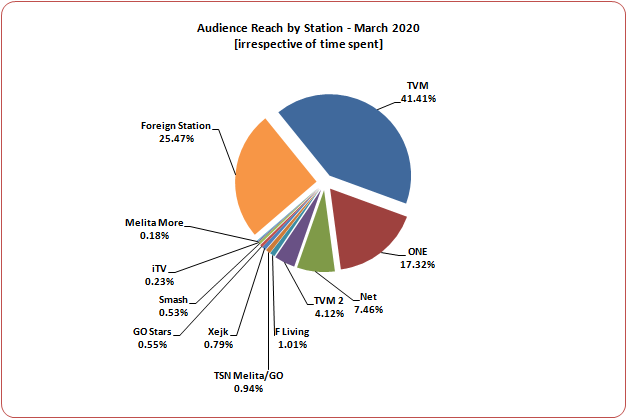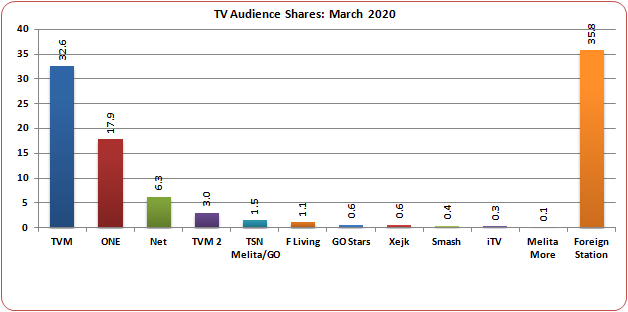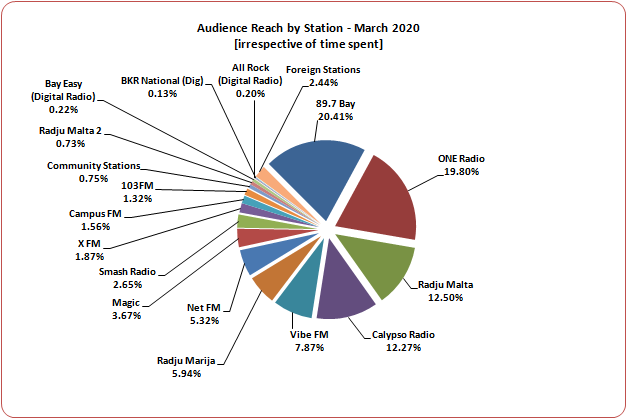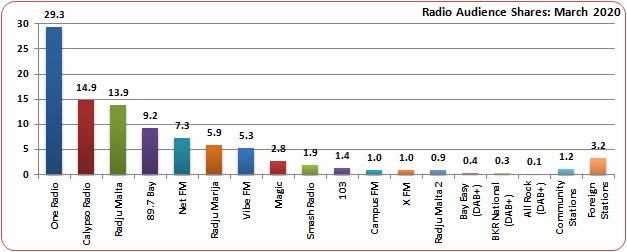Release: IMMEDIATE
Date: 17th June 2020
PR 08/20
March 2020 Audience Assessment
The Broadcasting Authority has released the audience assessment survey carried out in March 2020. The data for this assessment was collected during the month of March – a time when the first steps to combat the Corona Virus pandemic were being taken.
Forty daily questionnaires were compiled by the NSO giving a total sample of 1,240 respondents with the youngest being 12 year olds. Overall, this sample gives a margin of error of ±2.72%.
During March there was a marked increase in the amount of television audiences, the highest ever registered at 73.2% of the population as well as in the number of services used for watching television - +18.2% over the previous assessment period of November 2019. Over the whole population viewing television has increase by 12’36” over the previous assessment and over that of the same period last year.
On the other hand there was a notiveable decrease of 12% in the number of audiences listening to radio stations, the third lowest ever registered since February 2014 [43.7%; Feb 2015: 44.1%; Mar 2020:44.7%]. Even radio listening patterns have changed – during this period the highest peak was attained earlier [by 9:00am] and was sustained far longer [till 11:30am] than in previous assessments.
TELEVISION
As much as 73.2% of the population have watched TV during March. Compared to previous data, there was a significant increase of 8.1% of viewers over the previous assessment period of November 2019 (65.1%); and an increase of 9.8% of a similar period last year (March 2019 – 63.4%).
On average TV viewers have spent as much as 1.74hrs watching TV – this was 13’48” less than that registered at the previous assessment in November2019 (1.97hrs) but at the same level as that registered in March 2019 [1.74hrs]. On the other hand, over the whole of the population average viewing was 12’36” higher than that of November 2019 [1.72hrs] and was 12’36” higher than that registered for the same period last year [March 2019: 1.72hrs].
Audience Reach – Popularity:
Overall, while 72.9% of all viewers followed local TV stations, as much as 27.1% watched a foreign station. The largest amount of viewers were attained by TVM (41.41%), ONE (17.32%), and Net TV (7.46%) respectively. These stations had audiences from all the demographical groups by gender, by age-groups and by district with the exception of TVM2 which exceeded Net TV with all those under 30 years old while the reverse holds for all those over 30 years old with Net TV getting as much as twice the audiences of TVM 2.

There is clear evidence that TV viewing patterns have changed. While in previous assessments audiences rose steadily throughout the day, this time there was a marked increase in audiences from those at mid-morning to those at noon – in November 2019 average morning audiences amounted to approximately 12,800 while in this assessment audiences were a clear 30% more. Daily broadcasts of Covid-19 Updates have increased audiences by more than twice [≈40,000] the levels of those in November 2019 [≈17,400].
Peak Audiences:
Peak audiences of the top three local TV stations were:
- TVM on Thursdays with 30.71%
- ONE on Tuesdays with 14.03%;
- Net TV on Mondays with 5.40%.
TVM had the highest peaks amongst all stations for all the weekdays and exceeded those of foreign stations.
Average Audiences:
Taking the total average over a whole week [Monday to Sunday and excluding foreign stations] TVM attracted the largest average amount of viewers [1.842%]; followed by ONE [1.010%] and Net TV [0.508%].
TVM had the highest average amongst all stations on six weekdays – Sundays [2.166%], Mondays [1.881%], Tuesdays [1.849%], Saturdays [1.837%], Fridays [1.806%], and Thursdays [1.541%]. ONE had the highest average amongst all local stations on Wednesdays [1.780%].
Audience Share – Airtime:
The total airtime available for viewers was distributed as follows:

Excluding Foreign stations [35.5%], TVM ranked first with 32.6%; followed by ONE with 19.7%; and Net TV with 6.3%. TV viewers watching foreign stations did so for an average of 2.43hrs while viewers watching TVM did so for an average of 1.46hrs.
Restrictive movements have led to a rise in the consumption of television. More people have watched television leading to the highest ever registered national average of 1.93hrs. Consumers have continued to follow foreign stations much more than local stations – the daily average audiences of foreign stations have exceeded those of local stations for all the weekdays except for the audiences of Tuesdays where TVM’s average audiences was the highest amongst all stations.
However, local stations have attained viewership peaks at any half-hour slot far higher than those of foreign stations during all the weekdays. And although more people have followed local stations than foreign stations these were on average far shorter and, overall, more time was spent following foreign stations than local stations.
Favourite Programme Genres:
The most favourite programme genres named by respondents are: Local & Foreign News (26.5%); local Drama (14.5%); Discussion & Current Affairs (10.5%); Documentaries (9.6%); and Cultural/Educational programmes (9.4%).
The ranking of preferences has not changed and there was little change in percentages except for Local and Foreign News [26.5%] – there was an increase of 7.1% for this item over the previous period of November 2019 [19.4%] and an increase of 6.4% of the same period last year [March 2019; 20.1%].
Television service:
The most common type of reception service provided to television viewers is through a paid subscription – 91.8%. The next most common are IT based services [46.3%]; followed by satellite service (2.7%) and Free-to-air service [1.8%; ≈8,000]. Of all the respondents who stated that they have a free-to-air service62.5% [≈5,100] have stated that they only have this kind of service.
There was a marked increase in the number of services used – as much as an 18.2% increase over the previous assessment period of November 2019. The highest increase was that amongst the 21-30 year olds [35.2%] while there was a decrease of only 2.8% amongst those over 71 year old.
As a percentage over the whole population, the highest increase was that for Netflix [8.9% - amongst all the age groups] while the highest decrease was that for Free-to-air services [-2.0% - amongst all age groups except for 71+ year olds where there was a slight increase].
RADIO
Less than half of the population [44.7%] of the population have listened to Radio during March 2020. Compared to previous data, there was a 9.8% decrease of radio listeners over the previous assessment period of November 2019 [54.5%] and a decrease of 11.3% over that of a similar period last year [March 2019; 56.0%].
When respondents were asked how many times they listen to radio during a typical week 50.7% of the respondents have stated that they listen to radio every day [November 2019: 57.7%], 19.3% stated that they listen to radio at least once a week [November 2019: 14.7%]; 18.8% stated that they are are not regular radio listeners [November 2019: 22.2%]; while 9.2% stated that they never listen to radio [November 2019: 14.7%].
On average radio listeners have spent as much as 3.67hrs each. Compared to previous assessments, there was a decrease of 25’48” per listener over the previous assessment of November 2019 (3.24hrs) and an increase of 39’0” over that of a similar period last year (March 2019 – 3.02hrs).
Audience Reach – Popularity:
Over all the listeners, 89.7 Bay has attracted the largest amount of radio listeners [20.41%], followed by ONE Radio with 19.80% of all listeners, Radju Malta [12.50%], and Calypso Radio with 12.27%. Only two stations were followed by respondents from all the demographic groups – Radju Malta and Radju Marija.

Peak Audiences:
An indication of a radio station’s popularity is its highest amount of audiences obtained at any particular half-hour slot. ONE Radio had the highest peak amongst all stations on four weekdays – Fridays: 6.418%; Saturdays: 6.400%; Tuesdays: 6.044%; and Sundays: 4.998%. That of Fridays was the highest peak amongst all stations for the whole week.
Calypso Radio had the highest peak amongst all stations on Mondays: 6.169%.Radju Malta had the highest peak amongst all stations on two weekdays – Wednesdays: 5.873% and Thursdays: 5.850% - with that of Wednesdays being its highest during the week.
Average Audiences:
Taking the average audiences attained by each station on each week-day, ONE Radio attained the highest total average amongst all stations [1.941%]; followed by Calypso Radio [0.990%]; Radju Malta [0.919%]; 89.7 Bay [0.609%]; and Net FM [0.481%].
ONE Radio had the highest average amongst all stations for all the weekdays except for Thursdays with its highest on Tuesdays [2.577%] followed by that on Fridays [2.378%]. Radju Malta had the highest average amongst all stations [1.507%] on Thursdays.
Audience Share: Airtime
The total airtime available for radio listeners was distributed as follows:

Overall, ONE Radio ranked first with 29.3% of all audiences, followed by Calypso Radio [14.9%]; Radju Malta [13.9%]; 89.7 Bay [9.2%]; Net FM [7.3%]; Radju Marija [5.9%]; Vibe FM [5.3%]; and Magic [2.8%] while the rest had less than 2% of the audiences.
The radio listeners who have spent most time listening to their favourite radio station were those of ONE Radio [5.42hrs] followed by those of Net FM [5.0hrs]; Radju Malta 2 [4.51hrs]; Calypso Radio [4.46hrs]; Radju Malta [4.11hrs]; 103 [3.75 hrs]; Radju Marija [3.57 hrs]. On average all the radio listeners have spent as much as 3.67hrs listening to radio.
Similar to television there was a rise in the amount of hours consumers have spent following their favourite radio station. Restrictive movements have led to changes in listening patters – the highest peak of radio listening was reached earlier [09:00 am] than previously recorded [10:00 am] while audiences were more regular throughout the day and gradually diminishing for late-night listening.
However there were fewer listeners who usually listen to radio and although their average was the highest ever registered amounting to 3.67hrs per listener, the national average was within the norm.
Radio Favourite Programme Genre:
Respondents were asked what is their favourite radio programme. While 31.1% named a programme genre another 11.0% named a specific programme; while another 5.1% either said that they like all programmes on radio or “all” on a specific radio station.
Out of those who named a programme genre, the most quoted were Music programmes [59.6%], another 8.4% Music, 5.5% Prayers & Religious programmes; and 5.2% Discussion programmes.
As much as 11% of the respondents named a specific programme which they like to follow. The most named programmes were those classified as “Morning Drive” programmes [44.98%]; followed by “Daytime” programmes [41.68%]. Only 3.63% of the programmes named were for “Overnight” programmes.
DAB+ Radio:
12.6% of respondents have stated that they have a DAB+ radio-set – 58.2% of these have stated that they listen to their DAB+ radio-set for local stations only, another 33.5% stated that they listen to both local and foreign stations, while 6.2% stated that they follow foreign stations only. The rest [2.2%] have stated that they do not use their DAB+ radio-set.
The full version of the results of the survey can be downloaded from the Authority’s website.
Mario Axiak, M.B.A (Maastricht)
Head, Research & Communications
17th June 2020
Click here for Press Release 08/20
Click here for the full Assessment of March 2020
Click here for previous assessments